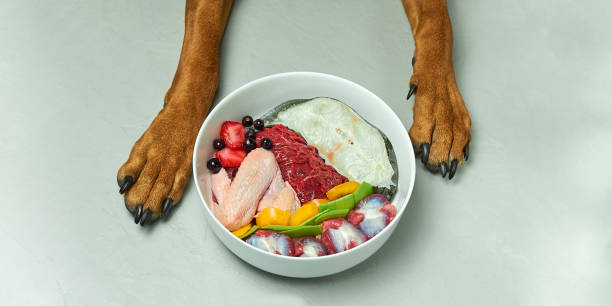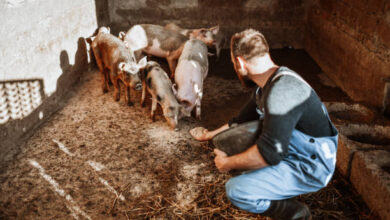
What Is Chicken Meal in Dog Food? Its Benefits and Risks
If you’ve ever read the ingredient list on your dog’s food bag, you might have come across “chicken meal.” But what exactly is it? Chicken meal is a common ingredient in many dog foods, yet its presence often raises questions among pet owners. In this guide, we’ll explore what chicken meal is, its benefits and potential risks, and how to choose high-quality chicken meal dog food.
Definition and Composition of Chicken Meal
Chicken meal is a rendered product made from chicken parts, excluding feathers, heads, feet, and entrails. The rendering process involves cooking the chicken at high temperatures to remove water and fat, resulting in a concentrated protein source. Chicken meal typically contains high levels of protein, vitamins, and minerals, making it a nutritious ingredient for dog food.
Definition: A rendered product from chicken parts, excluding feathers, heads, feet, and entrails.
Process: Chicken meal is made through rendering, which involves cooking chicken parts at high temperatures to remove water and fat.
Nutritional content: Chicken meal is rich in protein, vitamins, and minerals, providing essential nutrients for dogs.
Statistics/Facts
Chicken meal can contain up to 300% more protein than fresh chicken due to its concentrated nature.
Nutritional comparison shows that chicken meal often has higher protein content per pound compared to whole chicken.
Benefits of Chicken Meal in Dog Food
Chicken meal offers several advantages that make it a popular choice in dog food formulations.
High protein content: Chicken meal is an excellent source of protein, which is essential for muscle development and maintenance in dogs.
Concentrated nutrients: Because it is a dried product, chicken meal contains more nutrients per pound compared to whole chicken.
Cost-effective: Chicken meal is more affordable for manufacturers, which can lead to lower consumer prices without sacrificing nutritional quality.
Potential Risks and Concerns
While chicken meal has many benefits, it’s essential to be aware of potential drawbacks and concerns.
Quality variability: The quality of chicken meal can vary significantly between manufacturers. Some may use lower-quality ingredients, affecting the nutritional value.
Potential allergens: Some dogs may be allergic to chicken or chicken meal, leading to digestive issues and skin problems.
Misleading labels: Some manufacturers might use vague terms like “poultry meal,” which can include less desirable parts or lower-quality ingredients.
How to Choose High-Quality Chicken Meal Dog Food
Selecting high-quality chicken meal dog food involves careful consideration of the ingredients and the manufacturer.
Check the ingredient list: Look for named sources like “chicken meal” rather than vague terms like “poultry meal.”
Research the brand: Choose reputable brands with transparent sourcing and manufacturing processes.
Look for certification: AAFCO approval and other quality certifications can indicate a well-formulated product.
Additional Tips:
Read reviews: Customer reviews can provide insights into the quality and effectiveness of the dog food.
Consult your veterinarian: Your vet can recommend high-quality dog foods that suit your pet’s specific needs.
You May Love To Read:
Can Food Cause Anal Gland Issues in Dogs? A Guide
Can Rabbits Eat Grapes? Everything You Need to Know
What Do Baby Rabbits Eat? A Guide to Healthy Bunnies
Comparing Chicken Meal to Other Protein Sources
Understanding how chicken meal compares to other protein sources can help you make the best dietary choices for your dog.
Chicken meal vs. whole chicken: Chicken meal offers higher nutrient density and cost-effectiveness compared to whole chicken.
Chicken meal vs. beef meal: While both are high in protein, chicken meal is often more digestible and has a better nutrient profile.
Chicken meal vs. plant-based proteins: Chicken meal provides complete proteins essential for dogs, whereas plant-based proteins may lack certain amino acids.
Nutritional Comparison of Different Protein Sources in Dog Food
Below is a table comparing the nutritional content of chicken meal, whole chicken, beef meal, and plant-based protein sources. The values represent typical nutrient profiles per 100 grams of each protein source.
| Nutrient | Chicken Meal | Whole Chicken | Beef Meal | Plant-Based Proteins (e.g., Soy) |
| Protein | 65g | 20g | 55g | 36g |
| Fat | 10g | 8g | 12g | 18g |
| Moisture | 10% | 70% | 6% | 7% |
| Fiber | 0.5g | 0.1g | 0.4g | 5g |
| Calories | 340 kcal | 165 kcal | 280 kcal | 320 kcal |
| Amino Acids | Complete Profile | Complete Profile | Complete Profile | Incomplete Profile |
| Calcium | 4% DV | 1% DV | 3% DV | 15% DV |
| Iron | 10% DV | 6% DV | 8% DV | 15% DV |
| Vitamin A | | 3% DV | 7% DV | 2% DV | 0% DV |
| Vitamin B12 | 25% DV | 20% DV | 35% DV | 0% DV |
Key Benefits of Chicken Meal
- High Protein Content: Chicken meal has the highest protein content among the listed sources, essential for muscle development and maintenance.
- Lower Moisture Content: With only 10% moisture, chicken meal is a concentrated source of nutrients compared to whole chicken.
- Balanced Amino Acids: Chicken meal offers a complete amino acid profile, crucial for your dog’s health.
- Caloric Efficiency: At 340 kcal per 100 grams, chicken meal provides a dense source of energy, beneficial for active dogs.
- Nutrient Density: Chicken meal is rich in essential vitamins and minerals, supporting overall health and well-being.
Additional Notes
Whole Chicken: While nutritious, whole chicken has a high moisture content, resulting in a lower concentration of nutrients per gram compared to chicken meal.
Beef Meal: Similar to chicken meal, beef meal is a good source of protein but typically has a higher fat content.
Plant-Based Proteins: These proteins can be beneficial for dogs with specific dietary needs or allergies but often lack a complete amino acid profile and are higher in fiber and fat.
Conclusion
Understanding what chicken meal in dog food is can help you make informed decisions about your pet’s diet. By recognizing its benefits, potential risks, and how to choose high-quality options, you can ensure your dog receives the nutrition they need for a healthy and happy life.
Evaluate your dog’s current food today and consider the benefits of chicken meal. Share your thoughts and experiences in the comments below, and help other pet owners by sharing this post on social media.




